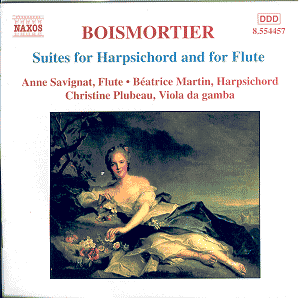Bodin De BOISMORTIER
(1689-1755)
Suites 1-4 for solo harpsichord (pièces de clavecin);
Suites 4, 5 and 6 (for flute traversière avec la
basse)
 Anne Savignat,
Flute;
Anne Savignat,
Flute;
Beatrice Martin, Harpsichord;
Christine Plubeau, Viola da gamba
Recorded at the church of Saint-Hippolyte, August
1998
 NAXOS
8.554457
NAXOS
8.554457
Crotchet AmazonUK
AmazonUS

I telephoned a friend who describes himself as "really a baroque man" he
is also a professional flautist and teacher of flute and recorder and asked
him what he made of Boismortier. He has played a considerable amount and
has some rare scores. "Oh", he said " he was a light-hearted but very skilful
composer for the flute" and for many that just about sums him up. Jean-Benjamin
de La Borde, writing 25 years after the composer's death, is quoted in the
booklet notes with the following doggerel:-
"Happy is he Boismortier, whose fertile quill
Each month, without pain, conceives a new air at will"
I well remember once complaining about a composer friend who composed pages
of music whilst in the bath or eating, my patient listener remarked "and
what is wrong with finding composing easy?" Perhaps it was Britten's oft-quoted
remark that composing was 5% inspiration and 95% perspiration that played
on my mind. It is a clever thing to say and one knows what he means, but
for some composers it is simply not always true and Boismortier was one.
Now that does not mean that he can only be frivolous. On a few occasions
on this disc I was struggling to tell the difference between him and his
exact contemporary Rameau. He shares with Rameau, and indeed the great Couperin,
who was over 20 years older, the pleasure of naming pieces in an extraordinary
way: L'Indeterminée (the undecided) in the 4th suite
for harpsichord. La Frénétique, which follows it, is
a fast and thrusting piece, which, to my ears, sounds as if it knows exactly
where it is going. I can't make out the significance of La Brunette (
yes … the brunette) a set of variations which ends the suite, unless
it is to some delicious court beauty who possibly had a propensity for dancing.
And what are we to make of La Marguillère? (the churchwarden).
The portentous double-dotted rhythms, I fear, say it all. Some pieces are
deep and thoughtful for example La Valétudinaire in the 1st
suite in a melancholy C minor.
The suites for transverse flute are elegant and often refined. They do not
have odd names and are more conventional. A prelude of delicate ornamentation
begins each and is followed by a set of dances: Air, Rondeau,
Musette, Gigue etc. One curiosity is that each suite is described
as being 'avec la basse' but the 4th suite is played only by solo
flute; not that it doesn't work, as such. In fact one was reminded that
Boismortier did write music for solo flute, (as did the great Jan van Eyck
1590-1657) but it seems that some one should have mentioned it on the CD
itself, a star is indicated at the back to show that Miss Plubeau on the
gamba is actually performing.
As for Boismortier's life, I wouldn't want to spoil a good story by letting
on too much, but I will quote the back of the CD "Boismortier became the
first composer whose income totally depended upon his ability to provide
a constant flow of new works. He had no patrons, few of his scores were
commissioned, and in his mature life he never appeared as an instrumental
musician. Such was his popularity as a composer that he became a wealthy
person." Yes, a wealthy free-lance composer, it is worth pondering and might
account for the jealousy that he encountered throughout his life.
Beatrice Martin has studied with Kenneth Gilbert, a great Rameau performer,
and Christophe Rousset who is a leading young harpsichordist, but it is excellent
that she has discovered music not played by either of her teachers. Anne
Savignat has made a particular study of the baroque flute and plays with
various early music ensembles. Christine Plubeau studied the gamba with Wieland
Kuijken and has made several critically acclaimed recordings.
Naxos have, for some years, given us, without fuss or a blaze of trumpets,
an excellent and worthwhile flow of French baroque chamber music, by young
and, in many cases, little known continental and American musicians. Indeed
a group called American Baroque recorded for Naxos in 1995 Boismortier's
6 Flute Sonatas with the extraordinary high Opus number of 91 appended to
them. As in this release, the players show a sure and technically sound skill
but also a perfect balance of mind and heart, which is a prerequisite of
an ideal performance of this often elusive music.
Gary Higginson

